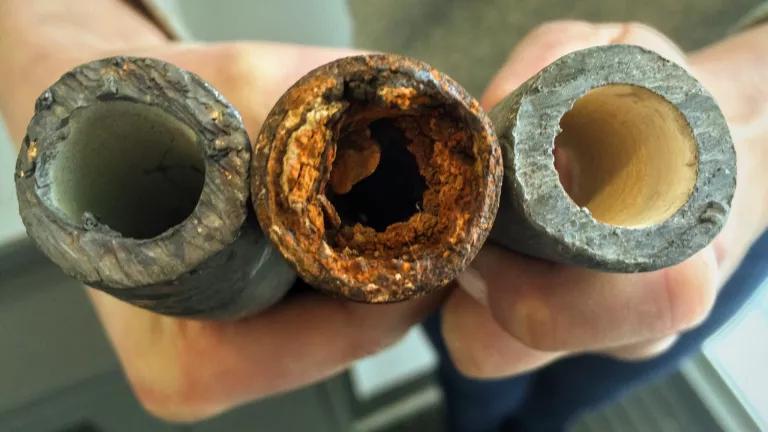What’s Great and What Needs Fixing in the EPA’s Proposed Lead Rule
The EPA would require most water systems to remove lead pipes within 10 years. That's great, but key improvements are needed.

Dee Dwyer for NRDC
The U.S. Environmental Protection Agency (EPA) recently proposed improvements to its rule on lead in drinking water, which include many encouraging changes that provide us hope that we may see a day when lead-contaminated tap water is no longer a nationwide crisis. The proposal offers some significant upgrades for the outdated and ineffective Lead and Copper Rule (LCR). It is also accompanied by unprecedented federal funding for lead pipe removal under the Bipartisan Infrastructure Law and other federal laws.
But important strengthening changes will be required for this rule to achieve President Joe Biden’s oft-stated goal of removing 100 percent of lead service lines within 10 years and to fully address the nationwide problem of lead in drinking water. We all have an opportunity to weigh in with the EPA at a virtual public hearing on January 16, 2024 (the deadline to register to speak is January 9), and with written comments that must be filed by February 5, 2024.
The good
The EPA’s proposal includes important improvements to the old LCR, including:
- A requirement that most water systems replace lead service lines within 10 years. The proposal establishes a general requirement that’s applicable to most water systems to replace all of their lead pipes. This would be required irrespective of whether the system exceeds a certain “action level,” and it is the proposal’s most important innovation.
- Better lead testing requirements, so water utilities will have to test both the first-draw water from the tap and the fifth liter of water coming from the tap. The latter represents water that has been sitting in the lead service line that may have high lead levels. This is likely to have a significant impact, because the original 1991 LCR monitoring requirements allow lead-contaminated water that has been sitting in the lead service line to be overlooked. And the 2021 Trump administration rule allowed lead from indoor (premise) plumbing to be ignored. The new approach, modeled after Michigan’s groundbreaking rules, will help to detect much of the lead from both sources.
- A requirement that utilities complete inventories of lead service lines, regularly update their inventory, and verify what pipes of unknown material are made of by a specific deadline.
- A reduced action level for lead from the previous 15 parts per billion (ppb) to 10 ppb, a measure that should drive improved treatment to reduce the corrosion that releases lead and copper into tap water. Also, in cases of repeated exceedances of the action level, the proposal includes a requirement that utilities make water filters available for certain homes, though it’s not clear that they need to be provided free (this should be clarified).
- The provisions relaxing requirements for small water systems are somewhat strengthened, so all small systems will have to replace their lead service lines. It also tightens up the rule so only systems serving 3,300 people or fewer would qualify for weaker lead in water requirements (the 2021 Trump administration rule allowed weaker protections for systems serving up to 10,000 people and allowed them to choose steps other than removing lead pipes to comply).
Areas needing improvement
Despite these and other improvements, the proposal has some significant shortcomings that need to be addressed to achieve the goal of ensuring that the nation’s lead contamination crisis is more fully addressed. Weaknesses of the proposal that require a fix include:
- Water systems are not required to pay for full lead service line replacement, potentially leaving significant cost burdens on individual households, and making it more difficult to reach the 100 percent replacement rate required under the new rule. This raises environmental justice concerns because low-income homeowners are often unable to afford to pay for lead pipe removal, and landlords often refuse to do so, meaning that too often, lower-income people continue to drink water contaminated by lead pipes.
- Lead pipes that utilities claim they don’t “control” don’t have to be replaced, even when the water system clearly has control (since they can always shut off the water, and the utilities generally required or approved use of the lead pipes). This could become a major loophole. Water systems will be allowed to claim they don’t “control” service lines, for example, when they require property owners to pay a substantial sum for full replacement and the homeowners or landlords are unable or unwilling to pay. Under the proposal, no replacement is required at these homes. Nor is replacement required at homes where the utility doesn’t reach and it must get permission from the property owner because the utility supposedly doesn’t “control” that pipe. Simple measures, such as adoption of a local ordinance like those in Newark, New Jersey, and Benton Harbor, Michigan, would fully resolve these control issues and ensure all lead service lines are replaced (see our model ordinance based on the Newark and Benton Harbor examples).
- Many water utilities will be allowed to get an extension for removing their lead pipes well beyond the 10-year deadline. The proposal includes two provisions allowing extensions of the deadline. The first is available to about three to seven systems nationally with more than 80,000 to 100,000 lead service lines—so a city like Chicago could get 40 to 50 years to replace its lead pipes. A second provision would allow around 600 to more than 2,100 water systems across the country that have a relatively high percentage of lead pipes to get extensions for as much as an additional decade or more. These provisions must be fixed; we cannot allow more generations of kids to continue drinking leaded water.
- Dropping the action level from 15 to 10 parts per billion (ppb) is an improvement but is insufficient and is still less strict than the 5 ppb standard urged by health experts, recommended by Canada and Europe, and applicable to lead in bottled water in the United States. It is also far less stringent than the 1 ppb maximum lead level that the American Academy of Pediatrics recommends for children in schools.
- Better public education and outreach is needed. While the proposal makes modest improvements in public education and the mandatory language on lead health effects, it needs to be clear that even water systems in compliance are likely to have many consumers (like those with lead service lines) who get health-threatening lead-contaminated tap water.
- Enforcement and reporting must be strengthened, since even with an action level at 10 ppb, enforcement is expected to remain weak without a universal requirement to immediately report test results and violations electronically to the EPA (past EPA audits show 9 out of 10 health-based lead violations are not reported to the agency).
- Schools and childcare centers must be meaningfully addressed. The proposal requires a single lead test at just five locations in each school and just two locations in a childcare center, once in the first five years, with no mandatory retesting or required notice to parents and staff. Lead problems will remain undetected and children unprotected. Even if notified of the test results, parents, children, and staff may be misled into thinking their water is safe, since lead levels can vary enormously from tap to tap and day to day. The rule should require utilities to either comprehensively and regularly test all water outlets at all schools and childcare centers, or work with these facilities to help them install water filtration stations. This would create the incentive for expeditious resolution of lead issues and reduce costs compared to removal and replacement of lead-containing pipes and fixtures.
This is by no means a comprehensive review of the hundreds of pages in the EPA’s Federal Register notice. We will be filing detailed comments addressing these and many other issues raised by the proposal and urge everyone to file their own comments with the EPA.
There are several important improvements included in the EPA’s proposed rule that deserve praise and provide much hope. Still, significant strengthening changes are needed to ensure that tens of millions of Americans who are drinking water from systems that have significant lead contamination issues are protected. Every person has the right to safe and affordable drinking water, no matter their race, income, or zip code. Now is the time for the EPA to be firm and seize the moment to advance toward this crucial goal.




